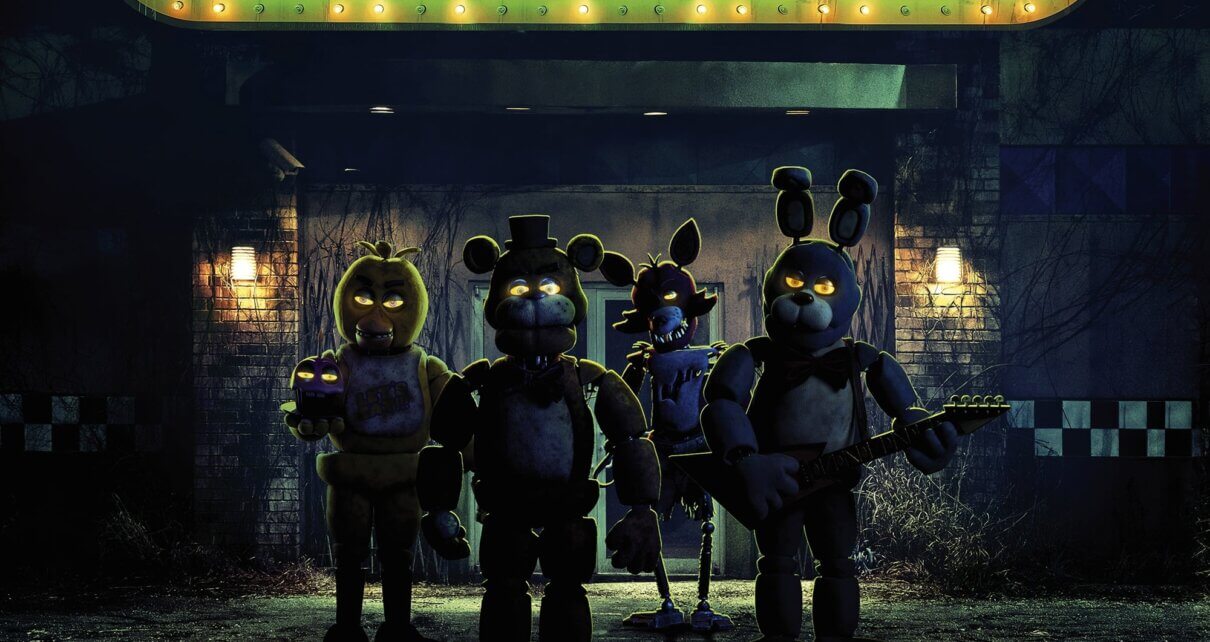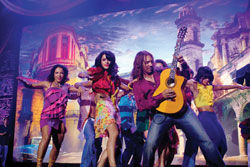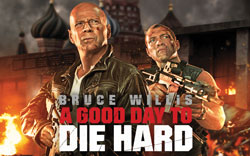Eight years in the making and anticipated by fans of the video game for even longer, Blumhouse Productions’ “Five Nights at Freddy’s” (dubbed “FNaF” by fans) was released on the streaming platform Peacock on Thursday, Oct. 26, and in theaters on Friday, Oct. 27.
For those who haven’t been obsessed since 2014 with the intricate lore conceived by video game creator Scott Cawthon—and excessively theorized upon by YouTube creators such as MatPat of The Game Theorists—the “FNaF” movie follows a 20-something Mike Schmidt, the first game’s victim of animatronic torment. Played by Josh Hutcherson, Mike is an older brother-turned-father-figure who starts his job as a nightshift security guard at Freddy Fazbear’s Pizzeria in order to provide for his little sister. The Pizzeria, much akin to that of a Chuck E. Cheese, is not up and running but rather abandoned and desolate since the 1980s after five children disappeared from the restaurant. As Mike learns more about his new job and the history behind the establishment, as well as meets the terrifyingly loveable animatronic mascots that still function, more horrors about the children and his own missing younger brother Garrett come unraveled.
For a media franchise that spans nine video games, a book trilogy, and two anthologies, the hour and 50 minutes of the “FNaF” movie barely scratches the surface of complex characters, gut-wrenching events, and nightmare-inducing animatronics, all of which fans have learned to adore over the past nine years. Nevertheless, the movie succeeds in its ability to tie together the most basic aspects of “FNaF” for a cohesive movie experience, despite critic reviews and a 30% rating on Rotten Tomatoes. An 88% audience score on the same site evenly disputes critics’ claims.
“FNaF,” as suggested by the contrasting ratings, is truly a movie for the fans. While there is little so-called “fan service,” enough Easter eggs are sprinkled throughout as a homage to those who have been here since the beginning. Watching iconic video game scenes—such as that of the spring lock trap and its accompanying line of “I always come back.”—play out on the big screen is only heightened by the excitement of those who know these moments’ true significance. Furthermore, special cameo appearances like that of the aforementioned MatPat himself and horror game YouTuber CoryxKenshin serve as a not-so-subtle thanks to those who helped make the intense popularity of the “FNaF” games a reality.
Though listed under the horror genre, “FNaF” certainly lacks any type of traditional horror that viewers may be expecting. Besides a few heavily implied animatronic-mauling scenes, viewers are safe from any sort of cringe-inducing guts and gore. Don’t let this undermine the movie’s ability to fright, however. The audience is instead thrilled by the mystery and threat that the larger-than-life animatronics pose, as their full capabilities are revealed early on in the movie. Even audience members who are ignorant of the extensive lore can enjoy the perfect balance of self-aware humor and tense moments. No one is free from bracing for impact every time an animatronic waltzes its way on screen.
The actors’ performances were crucial in helping this beast of a production come to life. Hutcherson, best known for his role as Peeta Mellark in the “Hunger Games” series, delivered a captivating portrayal of Mike Schmidt, his comedic timing juxtaposing perfectly with scenes depicting full-on terror. The familial chemistry between himself and Piper Rubio, who plays Mike’s little sister Abby, is palpable, and anybody who has a sibling themselves can appreciate the realism presented in scenes containing the two together. Hutcherson’s switches from irritated and exasperated to caring and protective of Abby emulate that of a real older brother, something that shows the true range of Hutcherson’s acting expertise.
Matthew Lillard, best known for playing Norville “Shaggy” Rogers in the 2002 live-action “Scooby-Doo” movie, portrays Mike’s quirky career counselor Steve Raglan. Lillard, however, impresses with his knack for the insane when it’s revealed that Steve is, in fact, William Afton, the five missing children’s murderer who stuffed their bodies in the animatronics’ suits. Yet again, Lillard proves to be another example in “FNaF” of a flexible actor, as he leaves the audience electrically stunned with his thirst for blood and lack of remorse.
Perhaps the most pivotal “actors” of all were the four massive animatronics of Freddy Fazbear, Bonnie, Chica, and Foxy, who Jim Henson’s Creature Shop—the same Jim Henson of The Muppets—brought to life. Manned by multiple puppeteers each, the animatronics were nothing short of astonishingly lifelike. Their uncanny appearances caused even more unease as viewers watched these creations independently roam the halls of the Pizzeria.
Overall, while not traditional horror, “FNaF” ranks up there with some of the most notable horror films of all time. According to Forbes, “FNaF” grossed $78 million in its opening weekend, far surpassing its $20 million budget and constituting itself as the third-highest opening weekend box office total for any horror film. “FNaF” only stands behind 2017’s “It” and 2019’s “It: Chapter Two,” numbers one and two on the list, respectively. With its cult fan base and intriguing plot for any newcomers, it’s no surprise that “Five Nights at Freddy’s” is where people want to be.




